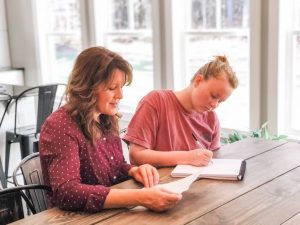
Homeschool Curricula For Dyslexia and Dysgraphia
March 14, 2022When teaching a child with dyslexia to read, there are a few things to keep in mind, a specific dyslexia homeschool curriculum, as well as some techniques to facilitate learning.
First, dyslexia is not a cause of lower intelligence. Dyslexic children have average and above-average intelligence. Also, most are right-brained dominant, so that is something to keep in mind when tapping into the best methods for learning.
Right-brained dominant learners have a tendency to think conceptually, intuitively, creatively, and holistically. They enjoy looking at and thinking in pictures and images.
When teaching these kinds of students, using visual materials and tools to assist in the learning process is more effective.
Tools for Homeschooling Dyslexic Children
- chalkboard or whiteboard use
- posters
- colors for certain parts of spelling/reading site words that are challenging
- vocabulary words in different colors within sentences or learning them with pictures
- drawing or coloring pictures, poster, cartoon strips to demonstrate knowledge of concepts and keeping notes

Using multi-sensory activities assist in the learning process as well. Tapping out syllables with hands or fingers uses body and sound. Use of discussion, audio-visual resources and projects should be incorporated. All of these can be tied to whatever reading time you have together to reinforce comprehension instead of the usual comprehension question/answer worksheets or standard book report. They also enhance the pleasure of reading instead of making it a challenging chore.
Site words can be a challenge, especially when they do not follow any rules. Writing them out on index cards and using color is effective. When practicing these words, have your child trace over the letters with a marker and his fingers while saying each letter and finish by saying the word. Then move to writing them with his finger while looking at the word and then without looking, saying the letters and the word.
Dyslexia Homeschool Curriculum
The structured programs helpful to dyslexic learners mentioned below suggest the sight words at the appropriate times to include them into your reading instruction.
When teaching your learner to read, consistency in presenting rules of letter sounds and syllables one at a time until mastery is important. Do not present words for which your child hasn’t mastered the building block sounds. The daily reading instruction routine should be identical every day so your child is used to the pattern of instruction and can concentrate on the material.
Whole language reading instruction with books or games with scattered sequences do not work with these learners. Methodical phonics building on sounds and syllables are most effective.
Structured phonics reading programs such as Hooked on Phonics (which I used for my son step by step years ago before there were many choices for homeschoolers) or Orton-Gillingham-based programs are best. All About Reading is another sequential program to check out.
These programs are all spelled out with specific instructions and steps to follow for busy homeschool moms and help with using the program most effectively. There are even Orton-Gillingham certified instructors available for hire. A sampling of our favorites include:
More For Teaching the Student With Dyslexia
Once your learner has learned pieces and how they can put them together to make syllables and words, they are then ready to take them apart again. This is when they are more ready to tackle spelling and writing these words.
Fluency in reading is the last part of reading instruction. By following a consistent routine and schedule and focusing on mastery of words, your student is ready to work on fluency. Fluency is the ability to read the words in phrases and sentences smoothly, pausing and stopping at the correct places. Comprehension while reading will follow.
Consistent practice each day starting with phrases that become familiar will ease the path to fluency, eventually building to longer sentences. Repetitive reading of the same short segments will greatly enhance fluency.
Reading together, following with your fingers on the words is one method to use. Taking turns where you read first pointing to the words, followed by your learner is another. And lastly, allowing your learner to take the lead with you repeating any phrase where your learner shows a need for practice and repeats the correct phrasing after your correction is another effective technique to reinforce fluency skills.
Using the proper materials, techniques and consistent routines are key in assisting your child with dyslexia to become an effective reader.
Take it from a homeschool mom who knows; it really can be done with wonderful results!
Dysgraphia Homeschool Curriculum
When our daughter was young she struggled greatly with reversing her numbers. This caused a lot of difficulties when we worked with her on number recognition. She could count at a very young age, however, recognizing the numbers was hugely difficult. We realized that we had to approach teaching her math in a different way. Once we realized this, homeschooling was enjoyable again. Here are a few of our favorite homeschool curricula for dysgraphia.
- Math U See – this was a great place for us to start. She was able to begin connecting the numbers to physical objects that she could see.
- Teaching Textbooks – This is the program that really helped her turn the corner. We went from mom helping with math every day to her being able to do math on her own. A big win for this dysgraphia family!
- Mr. D Math – Now that our daughter is in high school, Mr. D Math has been a huge help. The teachers are wonderful and the classes are “live” through zoom. This was a great benefit for our student struggling with dysgraphia. The students are taught the material and then work on it through the week. They have the recorded video that they can watch over again.
Katie Glennon – Volunteer Contributor
Katie is a homeschool mom who graduated two boys who are now in college. Katie has an English and Secondary Education degree with classroom, online, and coop teaching experience as well as teacher training for grades PK through adult. Katie loves learning history through hands-on activities and science through nature exploration and has a passion for literature and the written word! Katie loves to share her experiences and joy for learning with other homeschoolers to help them make their journey more enjoyable and less stressful! Visit her at Katie’s Homeschool Cottage!
More Information About Dyslexia
Visit Our Homeschooling Special Needs Section
Teaching a Child with Dyslexia
The Flip-Side Strengths of Dyslexia
5 Facts About Dyslexia Parents Need to Know
Latest Posts

Guest Post by Gabriel Morse For several years, I sat for long hours every day behind one of those battleship gray desks in a windowless, dull, gray office. The pay was enough to take care…
Read more >
This post is sponsored by Little Monsters Universe. I'm Tina Salmanowitz, an advocate for homeschooling and science education. With over a decade of experience as a science educator (in class…
Read more >
This post is sponsored by Time4Learning. Before the pandemic, it was business as usual for Boca Raton resident Nikki Warris. Her two daughters, 5-year-old Natalie and 8-year-old Lexi were…
Read more >

